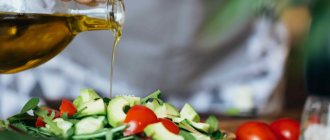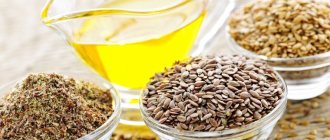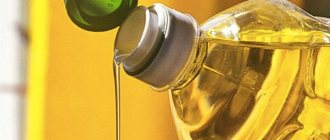December 31, 2022 Admin Home page » Important nutritional points
Is it worth buying rapeseed oil? What are the harms and benefits of using rapeseed oil? Is it possible to fry with rapeseed oil? Educational video.
Rapeseed oil – obtained from modified rapeseed (the seed of the canola plant). Since ancient times, rapeseed has been considered more of an industrial crop than a food crop due to the erucic acid it contains, which has a toxic component and an unpleasant taste.
Thanks to breeding work in Canada, canola has been developed that contains a reduced concentration of hazardous components. Before sale, the oil undergoes processing, which eliminates its bitter taste.
Rapeseed oil harm
As mentioned above, rapeseed oil naturally contains erucic acid and glucosinolates. The use of these substances can cause fibrotic heart disease called Keshana. Glucosinolates themselves are the cause of the bitter taste, which is why rapeseed oil in its natural form is not recommended for consumption.
Canola oil is already a practically safe product, but the big disadvantage is that in order to reach this state, the oil must go through many chemical processes.
Is canola oil dangerous for your health?
Another reason why rapeseed oil is considered harmful is the content of trans fats, but science has proven that their content is minimal. The modern deodorization and refining technologies used reduce the content of trans fats several times to the minimum acceptable level. It is worth noting that exactly the same processes are used in the processing of soybean, palm and sunflower oil.
Omega-3 concentration
The next indicator that causes dissatisfaction among followers of proper nutrition is the destruction of Omega-3 under the influence of refining. As a result of many hours of processing and refining, about 20% of linoleic acid is destroyed, but ultimately Omega-3 is at the level of 9-10%.
During the burning process, any oil converts Omega-3 into trans fats, which immediately manifests itself in a bitter taste. Some manufacturers minimize this phenomenon by carefully purifying the oil. Therefore, if the taste is bitter, the purification is poor and the trans fat content is increased and vice versa.
What do you need to know to choose oil for frying?
It's quite simple! When choosing oil for frying, preference should be given to oils that do not form harmful compounds when heated.
To understand whether your oil produces free radicals and harmful substances, you need to consider the following two points:
1) There should be a lot of saturated fat in the oil, and no more than 15% of polyunsaturated fat
2) In this case, the smoke point of the oil should be from 160°C
Now let's discuss each of the points in more detail.
Smoke point
The smoke point is the temperature at which an oil begins to smoke, burn, disintegrate, becomes toxic and is no longer safe for consumption. The higher this temperature (from 160 ° C ) , the safer it is to cook with such oil.
If oil is heated past its smoke point, it reacts with air and produces harmful compounds called free radicals.
They should not be inhaled or consumed in food because (as I wrote above) they are harmful to health and can damage your body cells and even DNA. One of the most harmful compounds that can be formed by heating is 4-hydroxynonenal, which is associated with the pathogenesis of vascular diseases, atherosclerosis, diabetes and neurodegenerative disorders. ()
I also want to point out that 4-hydroxynonenal has a cumulative property: the longer you heat the oil (or reuse it, as some fast food joints and restaurants are guilty of), the more you risk consuming it. Which is bad for your health. ()
But in addition to the smoke point, it is also important for us to consider the stability of the fatty acids that make up the oil.
Oil saturation and stability
The stability and heat resistance of the oil is determined by the amount of saturated fatty acids in its composition.
The more there are, the better! And that's why.
Any oil (like all products that contain fats) consists of three types of fatty acids - saturated, monounsaturated and polyunsaturated.
Saturated fatty acids, due to their straight structure and tightly packed molecules (which is why they are called “saturated”), practically do not oxidize when exposed to high temperatures. This is why butter and lard, which are mostly saturated fats, remain solid at room temperature.
Monounsaturated and polyunsaturated fatty acids do not have a straight structure. It contains unsaturated bonds that form a kind of bend in the chain. These bends become unstable when they come into contact with light, heat and oxygen.
Most of these bends are in the structure of polyunsaturated fatty acids. This means that oils containing large amounts of polyunsaturated fatty acids are more susceptible to oxidation, the formation of harmful breakdown products and the occurrence of inflammatory processes in the body.
Sunflower, soybean, corn, safflower, flaxseed and rapeseed oils are the most prominent representatives of vegetable oils high in polyunsaturated fats. They are the least heat stable and tend to oxidize more quickly and release more harmful free radicals during cooking. When polyunsaturated fatty acids are oxidized, they also form unhealthy molecules called lipid oxidation end products.
These oxidation products can cause an inflammatory reaction in the circulatory system, as well as in the liver, kidneys, lungs, intestines and generally have a negative impact on human health. ()
It is worth remembering that our main task when choosing oil is to choose products with a high smoke point, a maximum content of saturated fatty acids and a minimum amount of polyunsaturated fatty acids (no more than 15%).
Rapeseed oil benefits
Rapeseed oil contains approximately 7% fatty acids, which is about 50% found in olive, soybean and corn oils.
In addition, the composition contains useful oleic acid, which reduces the concentration of bad cholesterol, and the content of Omega-6 and Omega-3 is in an excellent proportion of 2:1. For example, the ratio of Omega-3 and Omega-6 in sunflower oil is disrupted, which can cause inflammatory processes and metabolic failures.
Can you fry with canola oil?
French fries were fried with canola oil for 7 days, resulting in an increase of up to 3.6% trans fat. Therefore, it is not recommended to cool and reheat rapeseed oil after heating, i.e. reuse is not advisable; it is better to use a new one each time.
At home, for cooking, refined oil will be healthier than soybean and sunflower oil, but will be inferior in concentration of nutrients to coconut and olive oil.
Refined or unrefined
Refined deodorized rapeseed oil of grade “P” is suitable for cooking. Unrefined is produced for other purposes:
- grade “T” - for technical use (biofuels, solvents, varnishes, paints, bioplastics);
- grades “R” and “SK” - for industrial processing into food products.
Adherents of a healthy diet choose domestic or imported refined rapeseed oil for frying meat, fish, and vegetables. Thanks to modern technologies, it contains no impurities that impair the taste or negatively affect health.
Shrimp fried in rapeseed oil
Cold pressed
Rapeseed seeds are cleaned, heated to 40 ℃, pressed, the oily liquid is filtered from impurities, and a first cold-pressed product is obtained. Unrefined fat obtained by cold pressing is not stable (sensitive to foreign odors, air oxygen, light, heat), is not suitable for frying, and has a peculiar taste and smell.
Refining
Refining minimizes the content of harmful substances (chemical pollutants, heavy metals, chlorophylls, carotenoids, thioglycosides), but retains healthy tocopherols and plant sterols.
At enterprises equipped with modern equipment, advanced technologies are used to produce high-quality food products:
- processing of raw materials with UV radiation;
- physical refining.
The smoke point of refined rapeseed oil is 204 ℃ , which means it can be used for frying.
To prepare tasty, healthy food, a temperature of 100−140 ℃ is sufficient
When the pan is heated this way, meat, fish, and vegetables are not stewed, but fried, vegetable fat does not burn, does not smoke, and dangerous carcinogens do not form in it.
How to use and store oils correctly
Once you have purchased the oil from a trusted supplier or company that has earned your trust, follow these simple tips to ensure that it remains fresh for a long time and imparts its beneficial properties to the products.
- Do not heat frying oil until smoking. You can see this in the pan when the oil starts to smoke!
- If you can reduce the cooking time of a dish or cook it at a lower temperature, do so.
- Try to fry the meat until golden brown as little as possible; if it is burnt or overcooked, it is best not to eat it. Yes, that’s why it’s better to eat grilled meat and shish kebab rarely.
- Also avoid deep browning of bread, potatoes and pastries.
- Never reuse oil.
- Always seal the oil tightly and do not leave it open for long to prevent it from oxidizing and going rancid. Rancid oils are a source of destructive free radicals.
- For the same reason, do not leave the oil in the light or in direct sunlight.
- Store oil in a cool, dry place.
- Buy olive oil in small airtight containers, preferably in dark glass containers. Avoid buying oil that comes in clear plastic containers, especially if you suspect it has been sitting on a shelf exposed to light for some time.
- If you buy large bottles/jars of olive oil, put a small portion of the oil into a separate bottle that you will use over the next few weeks. This way you can protect most of the oil from constant exposure to oxygen (when opening and closing the bottle).
Alternative cooking oils
The study of the properties of rapeseed oil continues, and debates about its benefits and harms do not subside. New research is needed to make clear, accurate conclusions. If you want to improve your diet and get the maximum benefit from home cooking, you should pay attention to alternative oils that are heat stable:
- Coconut oil is the best product for frying and helps increase the level of “good” cholesterol.
- Olive oil is rich in antioxidants, suppresses inflammation, heals the heart, and prevents neurodegenerative processes.
- Avocado oil is rich in plant polyphenols, carotenoids, antioxidants, and is not destroyed at high temperatures.
In their raw form, it is recommended to use the following oils for flavoring salads:
- Flaxseed oil - recommended for hypertension, to eliminate foci of internal inflammation.
- Walnut oil - indicated for diabetes mellitus and high levels of total cholesterol.
- Hemp – provides nutrients and improves the taste of dishes.
Given the mixed opinions among experts, you should consult your doctor or an experienced nutritionist before you start consuming rapeseed oil.
What is important to know about vegetable and animal fats
Basically, all natural oils are suitable for food and cooking in one way or another. If you have a whole collection, this is only a plus. After all, with them you get a variety of vitamins and acids.
However, you can cook it in different ways. Almost all vegetable fats are suitable for cold dishes, such as salads. But for cooking at high temperatures there is a limited list. Not everything is suitable for baking, frying and stewing.
Most butters (another name for oil) cannot withstand temperatures above 100 degrees. When heated, some of them form free radicals that are hazardous to health. Even if you have long forgotten your chemistry course, I will try to clearly explain why these elements are dangerous.
Free radicals are atoms that lack electrons. But nature has it in such a way that the shell of an atom should always be filled with negatively charged elementary particles. Therefore, as soon as a free radical appears, it looks for something to attach to in order to fill up. Just like in relationships between people!
What should you know about pan frying? ⇑
Chicken fillet with zucchini in a frying pan We talked to you about a variety of subtleties associated with frying dishes. The right choice of frying pan, stove, oil and compliance with many subtleties of cooking using this method - everything plays its role, everything is important in its own way. What is worth remembering if you decide to pamper your loved ones with fried food? Let's see:
- We pay attention to the smoke point of the selected oil (we cook it with butter carefully, we do not use unrefined sunflower oil at all).
- Heat the pan sufficiently (you can even wait a couple of minutes extra when you think the pan has reached the desired temperature).
- But at the same time, do not overheat the pan (so as not to spoil the coating and prevent the oil from smoking).
- Don’t overestimate the size of your frying pan (it’s better to fry in two batches than to end up with a bad dish).
- Dishes stuck to the pan may simply not have had time to set the crust. We wait or raise the temperature a little (if you initially did not heat it to the Maillard reaction temperature).
- Gas stoves are the most convenient heat sources for frying.
Having learned all about the intricacies of frying in a pan, you can consolidate your knowledge with practice! How about fluffy pancakes fried in delicate coconut oil? Or maybe you want to fry your favorite vegetables in olive oil? Experiment! And may cooking new dishes bring you pleasure both from the process and from such a delicious result!
[[]]
Taste qualities of oils
The taste of the oil depends not only on the quality and storage conditions of the raw materials, but also on the method of obtaining the oil. The most delicious and aromatic are unrefined oils. This is due to the high content of unsaturated fatty acids. For the same reason, they are not heat resistant and are not intended for frying.
To increase the smoke point, oils are subjected to purification (refining) and special processing (freezing, deodorizing). Such oils lose their natural taste and color. They become light and almost tasteless. But their resistance to heat increases. Such oils can already be used for frying without fear of harmful consequences.











